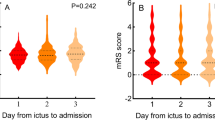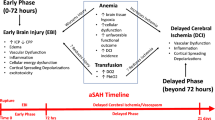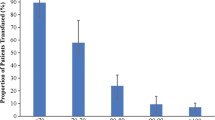Abstract
Objective
Anemia predicts poor outcome following aneurysmal subarachnoid hemorrhage (SAH). We hypothesized that this association would be stronger among patients with more severe SAH, since these patients are likely to be more vulnerable to secondary brain injury in the form of reduced cerebral oxygen delivery.
Methods
Daily nadir hemoglobin (Hb) concentrations over 2 weeks following SAH were retrieved in 245 consecutive patients, and compared between those with a favorable versus unfavorable outcome. The analysis was repeated with patients dichotomized as follows: WFNS score 4–5 vs. 1–3; modified Fisher score (MFS) 4 vs. 0–3; and vasospasm present vs. absent. Mixed effect models and multivariable analysis using the generalized estimating equation were employed to assess correlated data with repeated measures.
Results
Patients with an unfavorable outcome consistently had lower Hb concentrations, especially between days 6–11 following SAH (P ranging from <0.001 to 0.009), as well as a greater fall in Hb over time (β = −0.07, P < 0.001). This was true regardless of WFNS score, MFS, or the presence or absence of vasospasm. However, the effect was somewhat more pronounced among patients with higher WFNS and modified Fisher scores.
Conclusion
Lower Hb levels are associated with worse outcomes regardless of SAH severity or the development of vasospasm. This finding may imply that a lower Hb concentration is largely a marker for a greater degree of systemic illness, rather than necessarily causing direct harm. However, the association is somewhat stronger among patients with more severe SAH. Thus, if there is a benefit for maintaining higher Hb levels with transfusions or erythropoietin, it may be more pronounced among these patients.




Similar content being viewed by others
References
Solenski NJ, Haley EC Jr, Kassell NF, Kongable G, Germanson T, Truskowski L, et al. Medical complications of aneurysmal subarachnoid hemorrhage: a report of the multicenter, cooperative aneurysm study. Participants of the Multicenter Cooperative Aneurysm Study. Crit Care Med. 1995;23:1007–17. doi:10.1097/00003246-199506000-00004.
Wartenberg KE, Schmidt JM, Claassen J, Temes RE, Frontera JA, Ostapkovich N, et al. Impact of medical complications on outcome after subarachnoid hemorrhage. Crit Care Med. 2006;34:617–23. doi:10.1097/00003246-200612002-00426.
Kramer AH, Gurka MJ, Nathan B, Dumont AS, Kassell NF, Bleck TB. Complications associated with anemia and blood transfusion in patients with aneurysmal subarachnoid hemorrhage. Crit Care Med. 2008;36:2070–5. doi:10.1097/CCM.0b013e31816a8291.
Naidech AM, Drescher DO, Ault ML, Shaibani A, Batjer HH, Alberts MJ. Higher hemoglobin is associated with less cerebral infarction, poor outcome, and death after subarachnoid hemorrhage. Neurosurgery. 2006;59:775–80. doi:10.1227/01.NEU.0000232662.86771.A9.
Naidech AM, Jovanovic B, Wartenberg KE, Parra A, Ostapkovich N, Connolly ES, et al. Higher hemoglobin is associated with improved outcome after subarachnoid hemorrhage. Crit Care Med. 2007;35:2383–9.
Smith MJ, Stiefel MF, Magge S, Frongos S, Bloom S, Gracias V, et al. Packed red blood cell transfusion increases local cerebral oxygenation. Crit Care Med. 2005;33:1104–8. doi:10.1097/01.CCM.0000162685.60609.49.
Zygun D, Nortje J, Hutchinson P, Timofeev I, Menon D, Gupta A. Effect of red blood cell transfusion on cerebral oxygenation and metabolism following severe traumatic brain injury. Crit Care Med. 2009; (Personal correspondence, Dr. David Zygun) (in press).
Leal-Noval SR, Munoz-Gomez M, Arellano-Orden V, Marin-Caballos A, Amaya-Villar R, Marin A, et al. Impact of age of transfused blood on cerebral oxygenation in male patients with severe traumatic brain injury. Crit Care Med. 2008;36:1290–6. doi:10.1097/CCM.0b013e31818be317.
Oddo M, Milby A, Chen I, Frangos S, Maloney-Wilensky E, Stiefel M, Kofke WA, Levine JM, Le Roux PD. Hemoglobin level and cerebral metabolism in patients with aneurysmal subarachnoid hemorrhage: a microdialysis study. Stroke. 2009; (Personal correspondence, Dr. Peter Leroux) (in press).
Mayberg MR, Batjer HH, Dacey R, Diringer M, Haley EC, Heros RC, et al. Guidelines for the management of aneurysmal subarachnoid hemorrhage. A statement for healthcare professionals from a special writing group of the Stroke Council, American Heart Association. Circulation. 1994;90:2592–605.
Kramer AH, Gurka MJ, Nathan B, Dumont AS, Kassell NF, Bleck TP. Statin use was not associated with less vasospasm or improved outcomes following subarachnoid hemorrhage. Neurosurgery. 2008;62:422–7. doi:10.1227/01.neu.0000316009.19012.e3.
Jennett B, Bond M. Assessment of outcome after severe brain damage. Lancet. 1975;1:480–4. doi:10.1016/S0140-6736(75)92830-5.
Report of World Federation of Neurological Surgeons committee on a universal subarachnoid hemorrhage grading scale. J Neurosurg. 1988;68:985–6.
Frontera JA, Claassen J, Schmidt JM, Wartenberg KE, Temes R, Connolly ES Jr, et al. Prediction of symptomatic vasospasm after subarachnoid hemorrhage: the modified Fisher scale. Neurosurgery. 2006;59:21–7. doi:10.1227/01.NEU.0000218821.34014.1B.
Kramer AH, Hehir M, Nathan B, Gress D, Dumont AS, Kassell NF, et al. A comparison of three radiographic scales for the prediction of delayed ischemia and prognosis following subarachnoid hemorrhage. J Neurosurg. 2008;109:199–207. doi:10.3171/JNS/2008/109/8/0199.
Hijdra A, van Gijn J, Nagelkerke NJ, Vermeulen M, van Crevel H. Prediction of delayed cerebral ischemia, rebleeding, and outcome after aneurysmal subarachnoid hemorrhage. Stroke. 1988;19:1250–6.
Rosengart AJ, Schultheiss KE, Tolentino J, Macdonald RL. Prognostic factors for outcome in patients with aneurysmal subarachnoid hemorrhage. Stroke. 2007;38:2315–21. doi:10.1161/STROKEAHA.107.484360.
Corwin HL, Gettinger A, Pearl RG, Fink MP, Levy MM, Abraham E, et al. The CRIT study: anemia and blood transfusion in the critically ill-current clinical practice in the United States. Crit Care Med. 2004;32:39–52. doi:10.1097/01.CCM.0000104112.34142.79.
Nguyen BV, Bota DP, Melot C, Vincent JL. Time course of hemoglobin concentrations in nonbleeding intensive care unit patients. Crit Care Med. 2003;31:406–10. doi:10.1097/00003246-200301001-00001.
du Cheyron D, Parienti JJ, Fekih-Hassen M, Daubin C, Charbonneau P. Impact of anemia on outcome in critically ill patients with severe acute renal failure. Intensive Care Med. 2005;31:1529–36. doi:10.1007/s00134-005-2739-5.
Knaus WA, Draper EA, Wagner DP, Zimmerman JE. APACHE II: a severity of disease classification system. Crit Care Med. 1985;13:818–29. doi:10.1097/00003246-198510000-00009.
Harrison DA, Parry GJ, Carpenter JR, Short A, Rowan K. A new risk prediction model for critical care: The Intensive Care National Audit and Research Center (ICNARC) model. Crit Care Med. 2007;35:1091–8. doi:10.1097/01.CCM.0000259468.24532.44.
Smith MJ, Le Roux PD, Elliott JP, Winn HR. Blood transfusion and increased risk for vasospasm and poor outcome after subarachnoid hemorrhage. J Neurosurg. 2004;101:1–7.
Hebert PC, Wells G, Blajchman MA, Marshall J, Martin C, Pagliarello G, et al. A multicenter, randomized, controlled clinical trial of transfusion requirements in critical care. Transfusion requirements in Critical Care Investigators, Canadian Critical Care Trials Group. A multicenter, randomized, controlled clinical trial of transfusion requirements in critical care. Transfusion requirements in Critical Care Investigators, Canadian Critical Care Trials Group. N Engl J Med. 1999;340:409–17. doi:10.1056/NEJM199902113400601.
Lacroix J, Hebert PC, Hutchison JS, Hume HA, Tucci M, Ducruet T, et al. TRIPICU Investigators; Canadian Critical Care Trials Group; Pediatric acute lung injury and sepsis investigators network. N Engl J Med. 2007;357:965–76. doi:10.1056/NEJMoa071533.
Vavilala MS, Lee LA, Lam AM. Cerebral blood flow and vascular physiology. Anesthesiol Clin N Am. 2002;20:247–64. doi:10.1016/S0889-8537(01)00012-8.
Haug T, Sorteberg A, Sorteberg W, Lindegaard KF, Lundar T, Finset A. Cognitive outcome after aneurysmal subarachnoid hemorrhage: time course of recovery and relationship to clinical, radiological, and management parameters. Neurosurgery. 2007;60:649–56. doi:10.1227/01.NEU.0000255414.70807.A0.
Zimmerman JE, Seneff MG, Sun X, Wagner WP, Knaus WA. Evaluating laboratory usage in the intensive care unit: patient and institutional characteristics that influence frequency of blood sampling. Crit Care Med. 1997;25:737–48. doi:10.1097/00003246-199705000-00006.
Author information
Authors and Affiliations
Corresponding author
Additional information
Supported in part by the Louise Nerancy endowment of The University of Virginia.
Rights and permissions
About this article
Cite this article
Kramer, A.H., Zygun, D.A., Bleck, T.P. et al. Relationship Between Hemoglobin Concentrations and Outcomes Across Subgroups of Patients with Aneurysmal Subarachnoid Hemorrhage. Neurocrit Care 10, 157–165 (2009). https://doi.org/10.1007/s12028-008-9171-y
Received:
Accepted:
Published:
Issue Date:
DOI: https://doi.org/10.1007/s12028-008-9171-y




